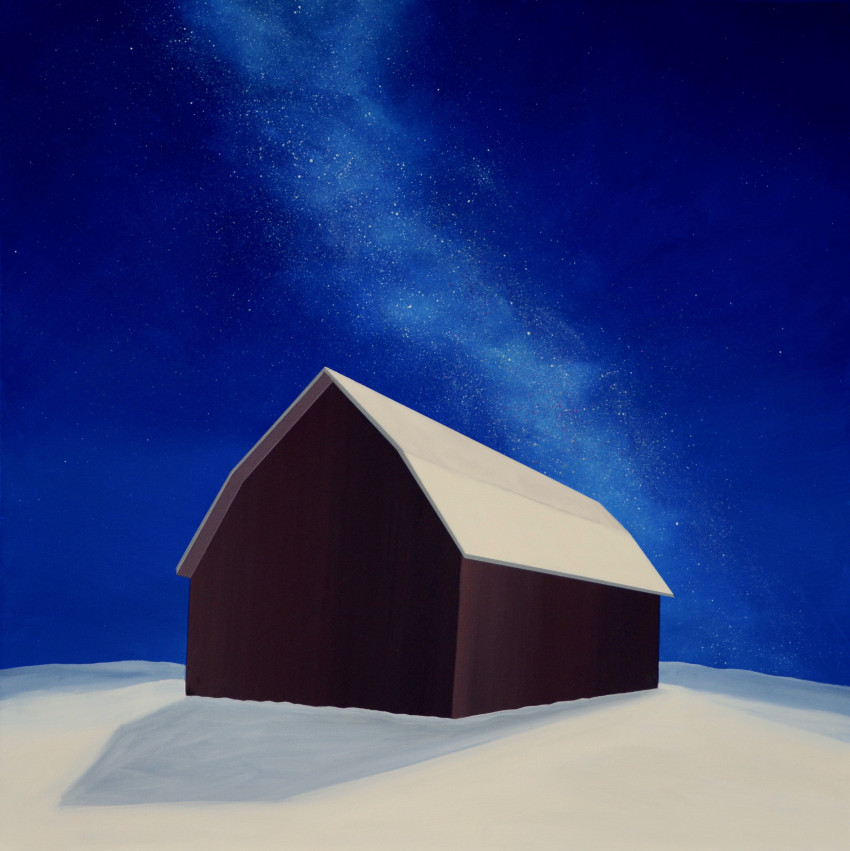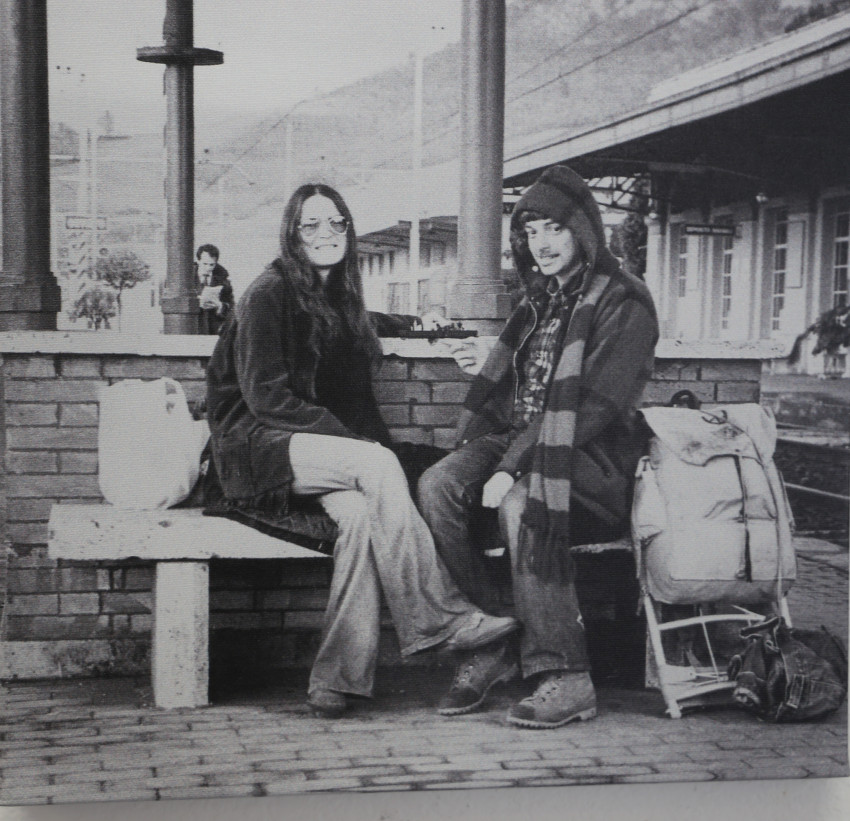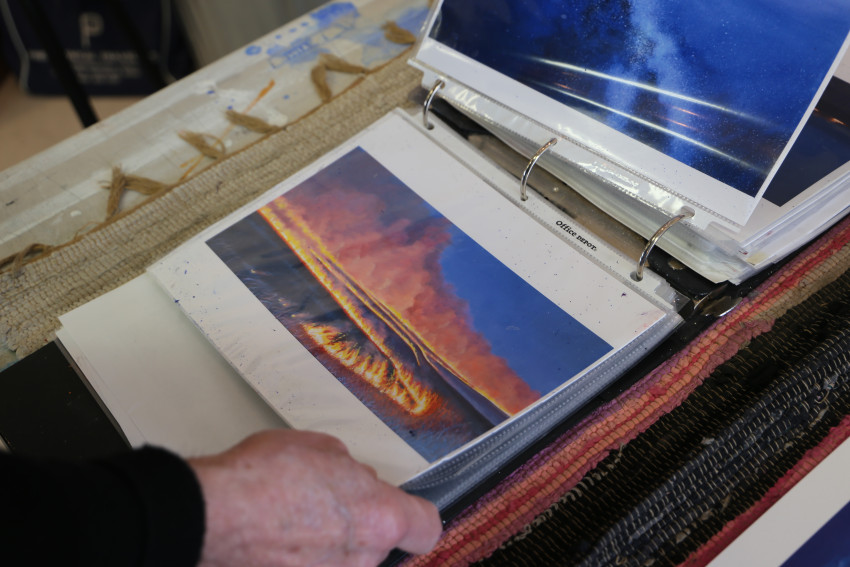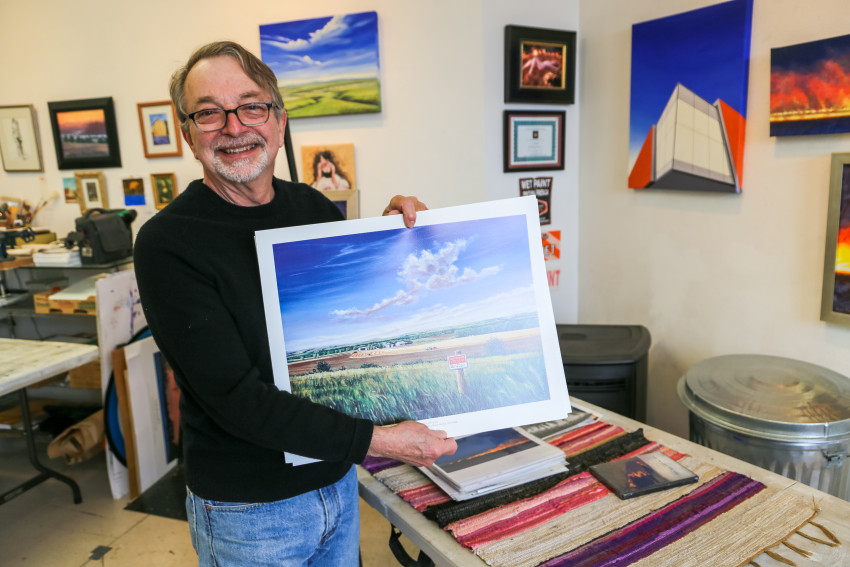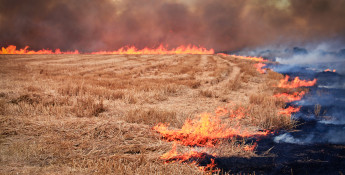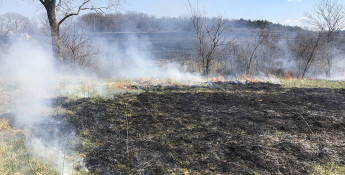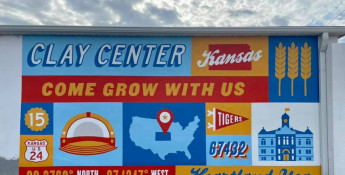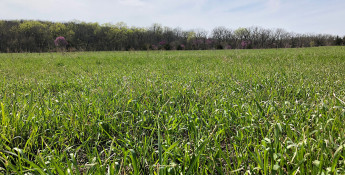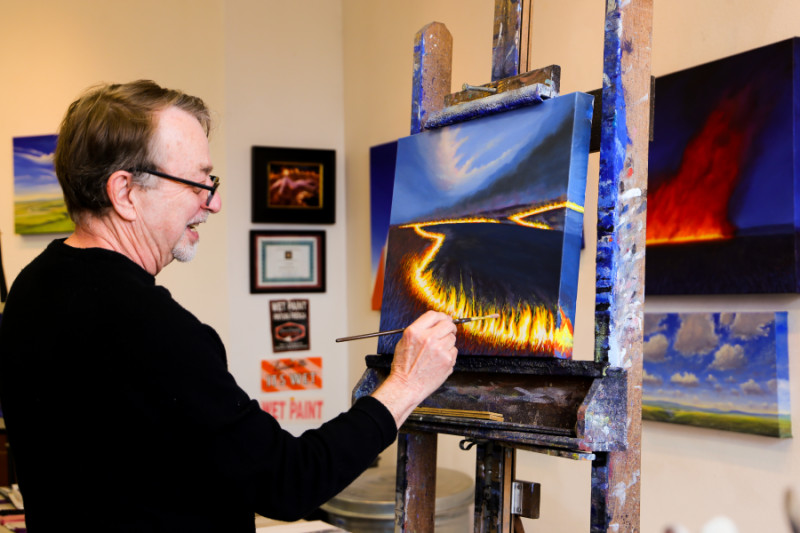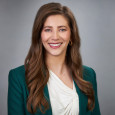By Sheridan Wimmer on January 29, 2024
Kansas artist showcases love of prescribed burning in the Flint Hills
Louis Copt has a passion for art and Kansas landscapes
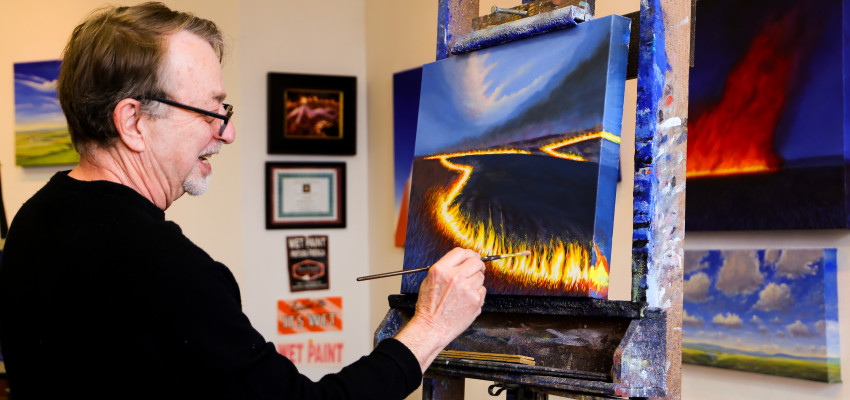
Each spring in Kansas, wildlife and humans alike seem to breathe a collective sigh of relief for getting through the winter. The retreat of the deep chill brings a new season of growth and color to the Kansas landscape. Some of that color may be seen as smoke in the skies when farmers and ranchers in the Flint Hills set fire to their prairie land. What seems a counterproductive practice has a history of ecological improvements and care for the land that is now deemed a necessity to maintain the grasslands in Kansas.
Drive through the Flint Hills after this method of land management and the color of the fresh, renewed grass is as vibrant as a sea of emeralds.
Louis Copt, a Kansas native, has made it his mission to capture this rite of passage from winter to spring through one-of-a kind paintings. His life’s work is based on the care farmers and ranchers have for the land and the mutual respect between the subject and the artist.
MEET THE COPTS
Louis was born and raised in Emporia and earned his degree in art from Emporia State University, where he also met his wife of more than 50 years, Phyllis. But his formative years of spending time with his French-Swiss grandparents on a farm near Osage City provided fond memories of milking cows and chasing chickens, and those memories eventually inspired his profession.
“My grandparents never had anything mechanized on their farm,” Louis says. “They worked everything by horse and wagon. They were strong. You have to be tough and smart to make a living on the land. That work ethic is how I think of what I do now as an artist — you have to work at it every day.”
Not only was his work ethic influenced by his grandparents, his time on their farm shaped his love of Kansas scenery.
“Running around on the farm instilled a love for Kansas and its landscapes,” Louis says. “Specifically, I remember the barn being the nucleus of the farm. That’s where the cattle were, the horses, the hay. That’s where my inspiration for my barn collection comes from.”
While at Emporia State University, Louis and Phyllis met Jim Hoy, a celebrated professor emeritus of English who taught for 45 years at the university. Jim is a Flint Hills native who grew up on a ranch near Cassoday. His son, Josh, now runs the family ranch.
“I’ve known Louis since the early ’70s when I first joined the faculty at Emporia State University,” Jim says. “I didn’t have Louis in class, but Phyllis was a student of mine, and I’ve visited with the Copts many times over the years. My son, Josh, has worked with Louis on his paintings a few times, and it’s always a joy to see artists and agriculturists joining forces.”
The Copts reside in Douglas County in a home that takes visitors on a journey of photos, paintings, sculptures — many of which are Louis’ creations — and even a wood-fired oven perfect for pizzas. There’s no lack of interesting things in the home — and no shortage of laughter from the couple.
One image on display is of the couple from their wedding day. Another is from their honeymoon when they hitchhiked through Europe.
“This is a bag of raisins,” Phyllis says as she points to the photo. “I didn’t know what a kilo was at the time, so I ordered that, and here we were with our two-pound bag of raisins.”
“Those raisins probably saved our lives,” Louis jokes. “We never missed a meal!”
FIERY PAINTINGS
Louis’ love of Kansas landscapes is evident in his collections that showcase the springtime prescribed burns to rejuvenate growth and protect against wildfires.
Prescribed burns, also called controlled burns, have been used in the Flint Hills for thousands of years. Native Americans used fire, which they called “the red buffalo,” to attract bison to the fresh green grass that came after the burns.
Throughout the years, intentionally setting fire to the Flint Hills caused the ecosystem to adapt, and continuing to utilize fire today maintains that ecosystem.
“Grasslands are dependent on three things — rainfall, which we can’t control; grazing, which we can control with grazing animals; and fire, which sometimes you can control,” Josh Hoy says. “If you don’t utilize fire in a controlled way, grasslands turn into a scrub forest, and you have horrible, destructive fires because there’s so much woody encroachment. Intentional, prescribed burning of prairie land prevents destruction and allows renewal.”
“Burning is a positive thing,” Louis says. “It is a practice that keeps the Flint Hills the Flint Hills. It is also an important stage in range management.”
Although wild herds of bison aren’t the primary reason for continuing the practice today, the historical significance of bison migration patterns and preference for freshly burned grasses persists.
“Everything we do with cattle, we want to mimic what migratory bison were doing,” Josh says. “That’s what the prairie has adapted to. It loves that migratory bison behavior, but it can be hard to mimic because bison would graze and leave for a year or two then come back when there was a burn or a big rain.”
Through a technique called patch burning, ranchers can graze cattle on a section of land that has been prescribed burned, then burn another section to move the grazing pressure.
When labor is short, however, land managers will opt to burn larger sections of land every three to five years — and sometimes even longer if conditions aren’t favorable.
“We haven’t burned for a couple of years because it’s been so dry,” Josh says. “We’re hoping we have a wet spring this year so we can burn again.”
Ranchers like Josh determine the best time to burn with the help of the Kansas Flint Hills Smoke Management website. It provides information about wind and humidity, regulations, research and more.
“A high humidity day is a lot safer and easier to burn in a controlled manner because the humidity in the air will slow the fire down a lot and make it easier to manage,” Josh says. “When there’s what’s called a red flag day, that’s when the wind’s blowing and there’s low humidity. If a fire gets started on a red flag day, it’s going to be hard to stop.”
Ranchers in Kansas know not to burn on red flag days. Safety is the main priority when considering the best day to burn, and it can all change quickly due to Kansas’ sometimes temperamental weather.
“No matter how well you plan, things can always change,” Josh says. “Making a burn plan is an important step in a safe burn.”
A burn plan, also available on the Flint Hills Smoke Management website, lists the objective of the burn, the description of the burn area including any woody plant species, a preparation outline that includes a burn permit and details of firebreak construction, plus a description of the conditions of air temperature, humidity, wind direction and speed, soil moisture and many other elements to implement a safe prescribed burn.
COLLECTING PASTURE BURNS
Louis works directly with farmers and ranchers he’s become friends with over the years, including the Hoys, to collect images of pasture burns he then paints from.
"I’ve known Louis through my parents for a long time, and he started coming out to the ranch to take pictures,” Josh says. “He’s always been the artist of fire in the Flint Hills to me.”
Since prescribed burning in the Flint Hills requires specific weather conditions, Louis and his contacts have a two-way system of getting in touch with each other when a controlled burn is planned.
“I’ll go out and photograph every spring to get inspiration photos of the controlled burns,” Louis says. “There’s a window of about one to two hours where the light is perfect. If it’s in the middle of the day, there isn’t a lot of drama. If you get the images too late, all you can see are the flames.”
From those photos, which Louis has collected in binders through the years, Louis paints what he calls a preservation of the past.
“I see my work as preserving a bit of Kansas for future generations,” he says. “You look at paintings of Paris from the 1800s and it’s this little slice of history that’s been captured. That’s how I want my paintings to reflect Kansas — a look back on what Kansas looked like.”
MUTUAL RESPECT
Just as farmers and ranchers must preserve respect for their land and livestock through various production practices like burning, Louis and the farmers and ranchers he works with have developed a mutual respect for each other’s craft.
“Louis understands ranching and farming and the importance of burning, and he captures it in a captivating, beautiful way,” Josh says.
The respect Louis has for farmers is evident in his work.
“Farmers are the salt of the earth,” he says. “They’re stewards of the land and love what they do, and it’s their passion. There’s a shared connection between the ranchers I work with and the work I do because there’s a mutual respect and love for the land.”
“Through their art, Louis, and other painters and photographers show the beauty, not the destruction, of these fires,” Jim says. “By drawing positive attention to the fires, they help educate the broader public about the Flint Hills — the last remaining substantial tallgrass prairie in the world.”
GIVING WAY TO RENEWAL
Louis sees his journey of becoming the artist he is now as a renewal of its own. Early in his career, he was a journalist at the Emporia Gazette. When the Copts’ son, Nathan, was 2 years old, they moved to Germany for approximately a year. When they came back to the United States in 1976, they settled in Lawrence — and after a few homes, they eventually designed and built the home they’re in now — complete with a studio and that impressive pizza oven.
Louis worked at Maupintour — a travel agency in Lawrence — where he did advertising and marketing until 1984, when he decided to quit with support from his wife.
“Phyllis was the one who said to me, ‘If you’re going to be an artist, you need to do it full-time,’” Louis says. “That’s when I quit my corporate job and moved to New York City to attend the Art Students League for a summer.”
He took a risk by quitting his corporate life and hasn’t looked back.
“It’s about finding your passion,” he says. “Being an artist was really what I wanted to be and needed to be.”
The land that is now the home of the Copts has seen fire itself. Before Louis and Phyllis built their current house, the previous home was destroyed in a fire. From the ashes, the Copts built a home where fire is present, but in a way that gives back instead of takes through Louis’ paintings — just like the farmers and ranchers of the Flint Hills are giving back to the land through prescribed burns.
Learn more about Kansas Flint Hills Smoke Management at www.ksfire.org.
Learn more about Louis Copt and sign up for his monthly e-newsletters at www.louiscopt.com.
Get to know the artist, Louis Copt
1. Did you always paint with oil?
I started painting watercolor landscapes – I did probably 300 watercolors a year. Most of them were Kansas winter landscapes. I transitioned to acrylic and now 90 percent of what I paint is oil on canvas.
2. You and Phyllis have been married for more than 50 years – that’s amazing. Where did you meet?
We met at Emporia State University, where we attended college. We got married in 1971 and our son, Nathan, now lives in Colorado with his wife, Britta, and our grandson, Campbell.
3. What are your hobbies?
I love Mexican music. I bought this fancy accordion to learn Norteño or Tejano music, but I can’t find anyone to give me lessons. I also love rowing – I’m a member of the Topeka Rowing Association and go to Lake Shawnee twice a week in the warmer months.
4. How do you get pumped up when you paint?
It drives Phyllis crazy, but I like to listen to laid-back electronic dance music. One of my favorite playlists is Purple Disco Machine.
5. Where is your work showcased?
I’ve had work included in the Wichita Art Museum, Kansas State University’s Marianna Kistler Beach Museum of Art, the Albrecht-Kemper Museum of Art in St. Joseph, the Spencer Museum of Art at the University of Kansas and the Phoenix Gallery in Lawrence. Plus, I have a lot of corporate collections, including one for Kansas Farm Bureau’s 75th anniversary.
You can also see my mural artwork in Manhattan (Night Fires in Post Rock Country) and in Lawrence.
I also have work in the Leopold Gallery in Kansas City, the Strecker-Nelson West Gallery in Manhattan and the Reuben Saunders Gallery in Wichita.
6. What is your favorite museum?
I love the Prado Museum in Madrid, Spain. Closer to home, the Nelson-Atkins Museum in Kansas City and the Spencer Museum in Lawrence.
7. Who are your inspirations or favorite painters?
I like Caravaggio, Michelangelo, Mark Rothko, Van Gogh, John Singer Sargent and Joaquin Sorolla.

